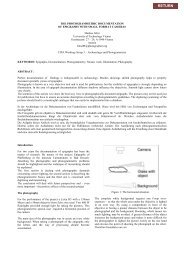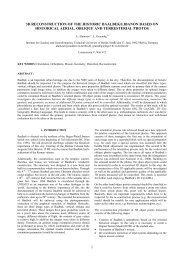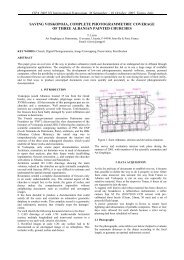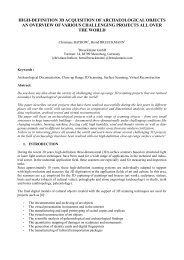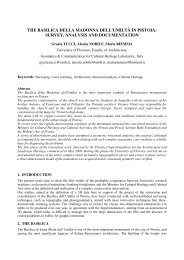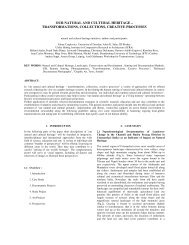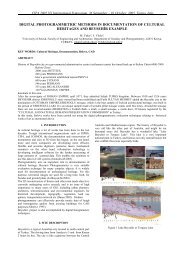CIPA HERITAGE DOCUMENTATION - CIPA - Icomos
CIPA HERITAGE DOCUMENTATION - CIPA - Icomos
CIPA HERITAGE DOCUMENTATION - CIPA - Icomos
Create successful ePaper yourself
Turn your PDF publications into a flip-book with our unique Google optimized e-Paper software.
➧ Identify and map evidences of criteria;<br />
➧ Significance and integrity assessment;<br />
➧ Risk assessment: threats and hazards associated to indicators;<br />
➧ Administrative and management issues (current and<br />
passed mitigations);<br />
➧ Other assessments.<br />
1.2.3 Practical issues when recording heritage<br />
places<br />
Figure 1: Defining a baseline, author.<br />
A good understanding of the recording heritage places requires<br />
the development of skills that recognize the following<br />
issues:<br />
➧ Nothing is straight, square or horizontal, heritage places<br />
are affected by weathering and their design might not be<br />
regular;<br />
➧ One should record from the wide to the small (fault theory);<br />
➧ Records should be referenced, it is advisable to link and establish<br />
a Basis and Control system;<br />
➧ The site baseline means that the heritage recording is to<br />
collect information of ‘as-built condition’, one should record<br />
only what is visible, although assumptions deduced from<br />
“logical” way of fabric should be mentioned;<br />
➧ Define an appropriate level of detail of the information to<br />
be provided;<br />
➧ All records should provide provenance information.<br />
1.2.3.1 Defining scope: levels of detail<br />
The following levels, developed by Letellier0 are presented<br />
here to provide an essential guide to define the amount of heritage<br />
information required for a specific objective in understanding<br />
heritage places. Each training course to be developed<br />
should specify, which of these levels are been taught.<br />
The levels are:<br />
➧ Reconnaissance;<br />
➧ Preliminary;<br />
➧ Detailed.<br />
1.2.3.2 The Reconnaissance Record<br />
Usually, the reconnaissance record is an overview photo survey<br />
that will allow conservationists to visualize, in their entirety, a<br />
site and its related buildings and features in sufficient detail to<br />
understand the site’s overall general characteristics. It should<br />
permit rapid identification of significant features and problem<br />
areas. The quantity of photos taken will vary with the size of the<br />
site and related structures and features, and the client’s requirements.<br />
For a building, a reconnaissance record would normally<br />
include elevations together with significant details. More<br />
complex sites such as cultural landscapes or archaeological excavations<br />
will require general views from all compass points<br />
and at various height elevations (that is heights of land), supplemented,<br />
as needs dictate, by representative details.<br />
1.2.3.3 The Preliminary Record<br />
Preliminary recording will complement the reconnaissance<br />
record by providing more complete information pertaining to<br />
the most significant elements of a site. The purpose of this<br />
record is to produce a record of the resource’s major features.<br />
Additionally, the preliminary record could include data necessary<br />
for preliminary analysis, and define areas for further investigation<br />
and future ‘detailed recording’. The accuracy of data is<br />
approximately ± 10 cm for plans, elevations, and cross sections,<br />
and ± 2 cm for structural and other structural details.<br />
1.2.3.4 The Detailed Record<br />
Detailed recording may take place prior to, during or after a<br />
conservation activity so as to record a site’s physical configuration,<br />
condition and significant features. Detailed recording<br />
occurs when a highly significant resource becomes the subject<br />
of directed research and analysis, or intervention planning<br />
and conceptual design. To ensure cost-effective detailed recording,<br />
completeness should be tailored to the immediate<br />
needs of a conservation team. Detailed recording may be<br />
phased over a number of years depending on planning requirements<br />
and related budget. The accuracy of a detailed record<br />
can vary between approximately ±5 mm (for details) and ±25<br />
mm (for building plans).<br />
1. IntroductIon to HerItage documentatIon<br />
11



